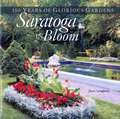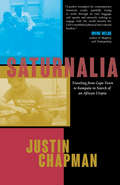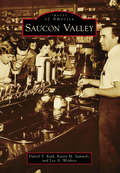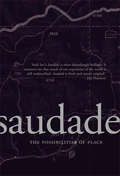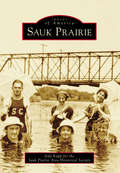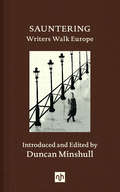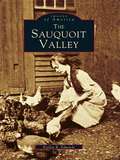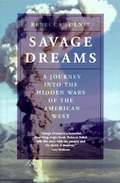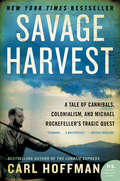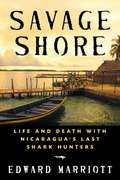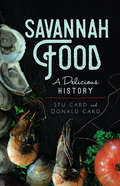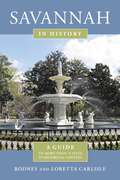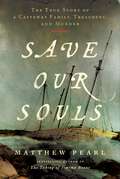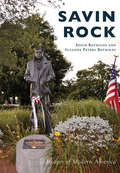- Table View
- List View
Saratoga in Bloom: 150 Years of Glorious Gardens
by Janet LoughreySaratoga Springs is colorful not only culturally and historically, but also literally. Come spring and summer the historic resort town is filled with lush plantings in the public parks, around private homes from the grandest to the most modest, at the Saratoga Race Course grounds and the Skidmore College campus, and even throughout the business district along Broadway. Rather than discouraging Saratoga's green thumbs, the challenging northern climate only inspires residents to celebrate the return of warm weather and the horse-racing season each year with joyful displays of gardens, fountains, and flower-filled containers of every description."History, health, and horses," the city's motto, neatly sums up Saratoga's most famous attributes. In this celebration of the region's gardens and the people who create them, photographer and writer Janet Loughrey shows us that "horticulture" should be added to that list.
Sass, Smarts, and Stilettos: How Italian Women Make the Ordinary, Extraordinary
by Gabriella ContestabileDiscover what's behind this seductive ethos of effortless chic, and how to live an extraordinary and stylish life, 'all' italiana'. Sass, Smarts, and Stilettos is not just a celebration of Italian women, but of all women; of their innate ability to think outside the box, to make magic from mayhem, and to have a wild good time doing it.
Satellites: Learn All About Satellites and Their Special Missions to Connect, Inform, and Protect All of US on Planet Earth (Adventures in Tech)
by Kate PeridotAn informative and beautiful guide to satellites for children.Satellites introduces children aged 7-9 to smart satellite technology and the ways satellites monitor the planet's health and help us take action.Every day, thousands of satellites orbit the Earth doing important jobs. Meet NOAA, Galileo, Aura, James Webb, and more, and find out about their special missions to connect, inform, and protect all of us on planet Earth.This science book for children offers: The start of a new series that combines space technology and earth science with elements of communication, conservation, and exploration.An inspiring book on the positive impact of technology in protecting and preserving our planet.A refreshing new perspective for space and technology curriculum activities that also explains how everyday tech works.Look up into a clear night sky and soon enough, you'll see a dot of light zip past. It’s not a shooting star, it's a satellite.The book uniquely combines Earth science and the latest space tech and is designed to fascinate and reassure. It includes a multitude of news-related themes: climate change, deforestation, wildlife tracking, storm/fire warnings, exploration, space junk, and more. There has never been a better time to learn about our 'eyes in the sky’.
Saturnalia
by Justin ChapmanIn the Spring of 2012, reporter and travel junkie Justin Chapman threw his cares to the wind and, by himself, set off on an epic journey across eight countries in Africa - from Cape Town, South Africa, to Mityana, Uganda - by bus, train, and boat. Along the way, he narrowly escaped being locked away in a mental institution, visited an impoverished township that is changing its future with the help of an art-based nonprofit, got into a life-threatening car crash, dropped acid on the mystical island of Zanzibar, lived with a group of Catholic priests, witnessed a witchcraft healing ceremony, discovered a pygmy opium den, and chased down riveting stories with a local journalist. He crossed cultural boundaries, found love and companionship in unusual places, and stared death - with all its visceral stench and gore - directly in the eyeballs. Saturnalia is an engrossing cultural anthropological treatise like none other. By embarking on a journey of self-discovery and survival, Chapman explores what Africa really has to offer, and in the process, discovers surprising and unexpected relationships between people and places.
Saucon Valley (Images of America)
by Karen M. Samuels Lee A. Weidner Daniel T. RuthBefore the first European settlers arrived in the Saucon Valley, the local Native American tribe, the Lenape, named the 17-mile, eastern Pennsylvania creek Saucon, meaning "at the mouth of the creek." Saucon Valley refers to the area drained by the Saucon Creek, a tributary of the Lehigh River. The valley includes Hellertown and Lower Saucon Township in Northampton County. Lower Saucon Township was chartered in 1743, when it was still a part of Bucks County. The township also included South Bethlehem until 1865, and Hellertown until 1872. Before becoming a borough in 1872, Hellertown was the largest village in Lower Saucon Township for many years. Even though the two municipalities remain separate, it is today impossible to disunite the families, culture, and history that have been interwoven through the years.
Saudade: The Possibilities of Place
by Anik SeeThe Portuguese word saudade has no direct English translation. In its simplest sense, it describes a feeling of longing for something that is now gone, and may yet return, but in all likelihood can never be recaptured.
Saudi Arabia - Culture Smart!
by Nicolas BucheleCulture Smart! provides essential information on attitudes, beliefs and behavior in different countries, ensuring that you arrive at your destination aware of basic manners, common courtesies, and sensitive issues. These concise guides tell you what to expect, how to behave, and how to establish a rapport with your hosts. This inside knowledge will enable you to steer clear of embarrassing gaffes and mistakes, feel confident in unfamiliar situations, and develop trust, friendships, and successful business relationships.Culture Smart! offers illuminating insights into the culture and society of a particular country. It will help you to turn your visit-whether on business or for pleasure-into a memorable and enriching experience. Contents include* customs, values, and traditions* historical, religious, and political background* life at home* leisure, social, and cultural life* eating and drinking* dos, don'ts, and taboos* business practices* communication, spoken and unspoken"Culture Smart has come to the rescue of hapless travellers." Sunday Times Travel"... the perfect introduction to the weird, wonderful and downright odd quirks and customs of various countries." Global Travel"...full of fascinating-as well as common-sense-tips to help you avoid embarrassing faux pas." Observer"...as useful as they are entertaining." Easyjet Magazine"...offer glimpses into the psyche of a faraway world." New York Times
Sauk Prairie
by Sauk Prairie Area Historical Society Jody KappRinged by bluffs, prairie, and the wide, flowing Wisconsin River, the two communities of Sauk City and Prairie du Sac have grown up since the first settler staked claim here in 1838, asserting this colorful, natural landscape as a direct extension of their joint identity. From the freewheeling Agoston Haraszthy to the German Freethinkers, farmers, inventors, and multiple long-standing family-run businesses, the people of Sauk Prairie work and play with a voracity that can outshine even the coldest of winters. In 1914, the construction of the Prairie du Sac Hydroelectric Dam added another natural jewel when it created Lake Wisconsin. Everyone from summertime jet skiers to the wintering bald eagles had yet another reason to enjoy the region known for its festival of cow chips, the Witwen Fourth of July Parade, and the woman who gave the world the recycling symbol.
Sauntering: Writers Walk Europe
by Duncan MinshullThis latest collection of walking literature from Notting Hill Editions celebrates the allure of the Continent.On foot the world comes our way. We get close to the Continent&’s alpine ranges, arterial rivers, expansive coastlines. Close to its ancient cities and mysterious thoroughfares; and close to the walkers themselves—the Grand Tourers and explorers, strollers and saunterers, on their hikes and quests, parades and urban drifts.Sauntering features sixty walker-writers—classic and current—who roam Europe by foot. Twenty-two countries are traversed. We join Henriette d&’Angeville, the second woman to climb Mont Blanc; Nellie Bly roaming the trenches of the First World War; Werner Herzog on a personal pilgrimage through Germany; Hans Christian Andersen in quarantine; Joseph Conrad in Cracow; Rebecca Solnit reimagining change on the streets of Prague; and Robert Macfarlane dropping deep into underground Paris.Contributors include: Patrick Leigh Fermor; John Hillaby; Robert Walser; Henriette d&’Angeville; Joseph Roth; Joanna Kavenna; Richard Wright; Werner Herzog; Robert Antelme; George Sand; Rainer Maria Rilke; Robert Macfarlane; Rebecca Solnit; Kate Humble; Nicholas Luard; Edith Wharton; Elizabeth von Armin; Joseph Conrad; D. H. Lawrence; Vernon Lee; Guy Debord, Mark Twain, Thomas Coryat, and more.
Sauquoit Valley, The
by Evelyn R. EdwardsThis unforgettable journey through the Sauquoit Valley includes some history, some nostalgia, and some relevant facts and tales of local people and places. Situated south of Utica in central New York State, this unique rural valley is dotted with villages, beginning at the southern end with Cassville and ending with New Hartford. Of historical interest are the names of the villages: how Washington Mills came to be nicknamed "Checkerville"; how the naming of Clayville after Henry Clay resulted in his visit in 1849; and the way Toad Hollow, Paris Furnace, Eagle Mills, and Bethelville evolved into the names used today. The valley became the site of numerous early factories and mills--gristmills, sawmills, cotton mills, and silk mills. Often the same businessmen ran factories in several of the villages. Mill owners had a paternalistic approach to their employees, providing not only jobs but also homes, recreational facilities, and even schools--a sharp contrast to the downsizing and forced retirement of today. The Sauquoit Valley looks at village life in the early 1900s through the lens of traveling photographers, such as A.J. Manning of Utica. These photographers recorded men and women and children in the clothing and fashions of the day, at their homes and shops and workplaces. Many of the photographs became real photo postcards.
Savage Dreams: A Journey into the Hidden Wars of the American West
by Rebecca SolnitSolnit offers a first-person account of her expeditions in California and Nevada, focusing on the politics and history of the Nevada Test Site and Yosemite National Park. She explores the connections between the political history of the West and its cultural history, which has been obscured by the reality of the violent past. Solnit weaves the story of the Danns, two Western Shoshone sisters who have fought the US government in an effort to reclaim their ancestral lands, into her narrative.
Savage Harvest
by Carl HoffmanThe mysterious disappearance of Michael Rockefeller in remote New Guinea in 1961 has kept the world, and even Michael's powerful, influential family, guessing for years. Now, Carl Hoffman uncovers startling new evidence that finally tells the full, astonishing story. On November 21, 1961, Michael C. Rockefeller, the twenty-three-year-old son of New York governor Nelson Rockefeller, vanished off the coast of southwest New Guinea when his catamaran capsized while crossing a turbulent river mouth. He was on an expedition to collect art for the Museum of Primitive Art, which his father had founded in 1957, and his expedition partner--who stayed with the boat and was later rescued--shared Michael's final words as he swam for help: "I think I can make it."Despite exhaustive searches by air, ground, and sea, no trace of Michael was ever found. Soon after his disappearance, rumors surfaced that he'd made it to shore, where he was then killed and eaten by the local Asmat--a native tribe of warriors whose complex culture was built around sacred, reciprocal violence, headhunting, and ritual cannibalism. The Dutch government and the Rockefeller family vehemently denied the story, and Michael's death was officially ruled a drowning. While the cause of death was accepted publicly, doubts lingered and sensational stories circulated, fueling speculation and intrigue for decades. The real story has long waited to be told--until now.Retracing Michael's steps, award-winning journalist Carl Hoffman traveled to the jungles of New Guinea, immersing himself in a world of former headhunters and cannibals, secret spirits and customs, and getting to know generations of Asmat. Through exhaustive archival research, he uncovered hundreds of pages of never-before-seen original documents and located witnesses willing to speak publicly for the first time in fifty years. In Savage Harvest Hoffman finally solves this decades-old mystery and illuminates a culture transformed by years of colonial rule, whose people continue to be shaped by ancient customs and lore. Combining history, art, colonialism, adventure, and ethnography, Savage Harvest is at once a mesmerizing whodunit and a fascinating portrait of the clash between two civilizations that resulted in the death of one of America's richest and most powerful scions.
Savage Shore
by Edward MarriottNicaragua's Atlantic coast is home to the most dangerous of fish, the bull shark, a lethal predator with a fearsome appetite and the only shark that swims in inland waters. Braving Nicaragua's hurricane-torn wilderness of mangrove swamps, Edward Marriott joins the last surviving shark fishermen to sail in a dugout canoe and fish for sharks with a hand line.As Marriott charts the life of the bull shark, its migrations, its voracious feeding patterns, and the treasures it offers -- oil for vitamins, hide for leather, and fins for soup -- he reveals lives spent in fear and awe in the shadow of a monster that can sniff fresh blood a mile away. He also tells a tale of human greed: an elemental community, battered by civil war and natural disasters, is now degraded beyond repair to the point of providing bounty for modern-day pirates.A gripping narrative of risk and adventure, a poignant record of loss and corruption, Savage Shore confirms Marriott as one of our most original and insightful travel writers.
Savages
by Joe KaneSavages is a firsthand account, by turn hilarious, heartbreaking, and thrilling, of a small band of Amazonian warriors and their battle to preserve their way of life. Includes eight pages of photos.
Savannah Food Crawls: Touring the Neighborhoods One Bite and Libation at a Time (Food Crawls)
by Jesse BlancoSavannah Food Crawls is an exciting culinary tour through on of Georgia's most beautiful cities. Each crawl is the complete recipe for the perfect tourist day, a new way to experience your own city, or simply food porn and great stories to enjoy from home. Put on your walking shoes and your stretchy pants, and dig into Savannah one dish at a time.
Savannah Food: A Delicious History (American Palate)
by Donald Card Stu CardSavannah’s remarkable cuisine is a reflection of its unique history. Delicate local ingredients are balanced carefully using time-honored techniques to produce unforgettable dishes. Initially a colonial experiment of sorts, Savannah became not only the first capital of Georgia but also the capital of all Lowcountry cuisine. From the insolvent freed from debtors’ prisons to help seek new cash crops for England to the religious refugees from Austria-Germany and the Scottish Highlanders, Savannah’s eclectic European influences mix neatly with traditional Gullah techniques, surprising local ingredients and world-class seafood. Follow authors and award-winning Savannah Taste Experience Food Tour operators Stu and Donald Card on their journey to find the roots of Savannah’s famed dishes and the current restaurant renaissance.
Savannah Winds
by Tamara McKinleyWhen Fleur receives word of a surprise inheritance from an aunt she never knew, it couldn't come at a more opportune moment. Her relationship is crumbling, and she's caught in the middle of a serious family rift. Consulting her aunt's long-lost diary, Fleur sets out on a voyage of historical discovery up the coast and through the Gulf Country, to the isolated cattle ranch Savannah Winds. But unbeknownst to Fleur, what she uncovers there could have devastating repercussions for her own life. Set between the 1930s and the modern day, Savannah Winds is an exploration of family ties, bitter rivalry and the strength of enduring love.
Savannah in History: A Guide to More Than 75 Sites in Historical Context
by Rodney Carlisle Loretta CarlisleSavannah in History features over 90 sites in Savannah, Georgia, presented organized by historical era, with over 100 color photos.This presentation is especially important for a city with a long and varied history like Savannah, where colonial sites are virtually next door to antebellum, Civil War, and important modern sites. This guidebook conveys a clear picture of the evolution of the city from its beginnings to the present and helps the tourist, and even the resident, unravel and understand the dozens of historic buildings and monuments and several excellent museums. Like the others in this series on St. Augustine, Key West, Charleston, and Tampa, it serves as both a guidebook and keepsake.
Savannah's Afterlife: True Tales of a Paranormal Investigator
by Ryan DunnIf you want to hear the real ghost stories of Savannah, you’ve come to the right place! Join Paranormal Investigator Ryan Dunn and his team, the Savannah Ghost Research Society, as they investigate the ghosts, histories, legends, and myths of one of the most haunted cities in the country. Read about eyewitness and personal accounts of people being attacked by ghosts, spirits that are not at rest, and places that continue to house the undead. Find out whether there is any truth to the story that people were buried alive at the Colonial Park Cemetery. Is the spirit of Dr. Brown “walled up” at a residence on West Oglethorpe Avenue, still grieving over the death of his family? Discover why people leave the Amethyst Inn in the middle of the night. Visit with poltergeists at the Chart House Restaurant at Bay and River Streets. Review the compelling factual evidence gathered by the team and then decide for yourself whether you’re brave enough to tour Savannah’s ghostly markers.
Save Our Souls: The True Story of a Castaway Family, Treachery, and Murder
by Matthew PearlINTERNATIONAL BESTSELLERFrom the bestselling author of The Taking of Jemima Boone, the unbelievable true story of a real-life Swiss Family Robinson (and their dog) who faced sharks, shipwreck, and betrayal.On December 10, 1887, a shark fishing boat disappeared. On board the doomed vessel were the Walkers—the ship’s captain Frederick, his wife Elizabeth, their three teenage sons, and their dog—along with the ship’s crew. The family had spotted a promising fishing location when a terrible storm arose, splitting their vessel in two and leaving those onboard adrift on the perilous sea.When the castaways awoke the next morning, they discovered they had been washed ashore—on an island inhabited by a large but ragged and emaciated man who introduced himself as Hans. Hans appeared to have been there for a while and could quickly educate the Walkers and their crew on the island’s resources. But Hans had a secret . . . and as the Walker family gradually came to learn more, what seemed like a stroke of luck to have the mysterious man’s assistance became something ominous, something darker.Like David Grann and Stacy Schiff, Matthew Pearl unveils one of the most incredible yet little-known historical true stories, and the only known instance in history of an actual family of castaways. Save Our Souls asks us to consider who we might become if we found ourselves trapped on a deserted island.
Save the Deli: In Search of Perfect Pastrami, Crusty Rye, and the Heart of Jewish Delicatessen
by David SaxDavid Sax's delightful travelogue is a journey across the United States and around the world that investigates the history, the diaspora, and the next generation of delicatessen. David Sax was alarmed by the state of Jewish delicatessen. As a journalist and lifelong deli lover, he watched in dismay as one beloved deli after another closed its doors, only to be reopened as some bland chain restaurant laying claim to the cuisine it just paved over. Was it still possible to save the deli? He writes about the food itself--how it's made, who makes it best, and where to go for particular dishes--and, ultimately, what he finds is hope: deli newly and lovingly made in places like Boulder, Colorado, longstanding deli traditions thriving in Montreal, and the resurrection of iconic institutions like New York's 2nd Avenue Deli. No cultural history of food has ever tasted so good.
Save the Florida Key Deer
by Margaret Goff ClarkThe tiny Florida Key deer need protection. The little deer of the Florida Keys are found nowhere else in the world. Related to the white-tailed deer, the Key deer is not much larger than a big dog. Today, it is an endangered species. There are no more than a few hundred left. The little deer wander through backyards and front lawns. Reduced speed limits are posted, but many deer get killed by automobiles. It is against the law to feed them. That makes them lose their natural fear of people and cars, and more likely to get killed. The National Key Deer Refuge was established on Big Pine Key in 1957, but more land is needed. People who live on the Keys like the little animals, and efforts are being made to find room for building developments and also enough space for Key deer to thrive.
Saved by Beauty: Adventures of an American Romantic in Iran
by Roger HousdenRoger Housden traveled to Iran to meet with artists, writers, film makers and religious scholars who embody the long Iranian tradition of humanism, the belief in scholarship and artistry that began with the reign of Cyrus the Great. He traveled to the mountains of Kurdistan to learn from Sufis, whose version of Islam exhorts nothing but tolerance and love. From the bustle of modern Tehran to the paradise gardens of Shiraz to the spectacular mosques and ancient palaces of Isfahan, Housden met Iranians who were warm, welcoming, generous, intellectually curious, and who would recite the poetry of Hafez or Rumi at the slightest opportunity. Saved By Beauty weaves a richly textured story of many threads. It is a deeply poetic and perceptive appreciation of a culture that has endured for over three thousand years, while it also portrays the creative and spiritual cultures within contemporary Iran that are rarely given any mention in the West. It is a suspense story that reflects on the philosophical and aesthetic questions of good and evil, truth and beauty. And finally, it is the story of a man in his sixties on a personal quest to discover if the Iran of his youthful imagination continued to exist, or whether it had been lost forever under a strict totalitarian regime. In Iran, Roger Housden was brought face to face with the reality that beauty and truth, deceit and violence, are inextricably mingled in the affairs of human life, and was forever changed.From the Hardcover edition.
Savin Rock (Images of Modern America)
by Edith Reynolds Suzanne Peters ReynoldsThe area surrounding Savin Rock in West Haven followed a traditional New England path that began as farmland for colonists. After the Civil War, however, that path took a new turn when entrepreneur George Kelsey constructed seaside attractions. After nearly a century of being home to the Savin Rock Amusement Park, once a popular tourist destination, the site had seen better days. The buildings were blighted and business had slumped as automobiles gave people the opportunity to visit attractions farther away. In 1964, Pres. Lyndon B. Johnson imagined a Great Society and declared a War on Poverty. West Haven took advantage of federal money to reclaim the Savin Rock, creating a mix of business, residences, and open, public space. This transition was not without growing pains as locally owned park concessions were eliminated, long-standing businesses were displaced, and residents were uprooted. When plans were proffered to reconstruct the area and line the shore with residential housing, this spurred a grassroots effort by local citizens who worked to keep the shore open to the public. Consequently, West Haven is home to Connecticut�s largest stretch of free, public beach, which is used by thousands every summer.
